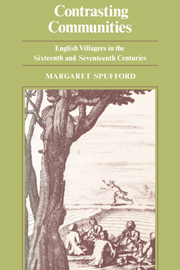Book contents
- Frontmatter
- Contents
- List of maps and graphs
- List of tables
- List of abbreviations
- Acknowledgements
- Dedication
- Introduction
- Map 1 Cambridgeshire: natural boundaries and soil types
- Map 2 Cambridgeshire: county and parish boundaries
- PART 1 People, Families and Land
- PART 2 The Schooling of the Peasantry
- PART 3 Parishioners and their Religion
- 9 Dissent before and after the commonwealth
- 10 A general view of the laity in the diocese of Ely
- 11 Fragmentation and the growth of sects
- 12 The possible determinants of dissent
- 13 The reality of religion for the villager
- Conclusion
- Appendix 1 The Butlers of Orwell
- Appendix 2 Notes on Graphs 3 and 5
- Index of Contemporary Names
- General Index
9 - Dissent before and after the commonwealth
Published online by Cambridge University Press: 25 January 2010
- Frontmatter
- Contents
- List of maps and graphs
- List of tables
- List of abbreviations
- Acknowledgements
- Dedication
- Introduction
- Map 1 Cambridgeshire: natural boundaries and soil types
- Map 2 Cambridgeshire: county and parish boundaries
- PART 1 People, Families and Land
- PART 2 The Schooling of the Peasantry
- PART 3 Parishioners and their Religion
- 9 Dissent before and after the commonwealth
- 10 A general view of the laity in the diocese of Ely
- 11 Fragmentation and the growth of sects
- 12 The possible determinants of dissent
- 13 The reality of religion for the villager
- Conclusion
- Appendix 1 The Butlers of Orwell
- Appendix 2 Notes on Graphs 3 and 5
- Index of Contemporary Names
- General Index
Summary
The attempt to discover anything about the beliefs of the villager is even more difficult than the attempt to discover anything about his education. The first statistics dealing with religion are post-restoration, and come from the Compton Census of 1676, which was an attempt to discover how far, and where, dissent had spread under the commonwealth. Its figures have been much disputed, but they form the most convenient starting point, with other post-restoration surveys like that of Bishop Laney of Ely, made in 1669, to gain some impression of what had happened amongst the peasantry under the commonwealth. It seems most feasible to start with these figures, and then work backwards in time to see what can be discovered of the Elizabethan genesis of dissent, if anything, before expanding on the growth of the various sects which flourished in Cambridgeshire, and discussing the social status of dissenters and their position in their communities. Finally, the most difficult task of all must be faced, that of trying to assess what importance individual religious convictions played in the lives of the common people.
In 1676, there were between four and five per cent of nonconformists in Cambridgeshire. The proportion was almost exactly typical of the country as a whole. An average figure is very deceptive, however, because nonconformity had obtained a really strong grasp in some areas and not in others. There were twenty-five villages in southern Cambridgeshire which, all the available records suggest, played a part as centres of dissent.
- Type
- Chapter
- Information
- Contrasting CommunitiesEnglish Villages in the Sixteenth and Seventeenth Centuries, pp. 223 - 238Publisher: Cambridge University PressPrint publication year: 1974



